最新人教版七年级英语下册第三单元知识点总结
- 格式:doc
- 大小:68.00 KB
- 文档页数:25
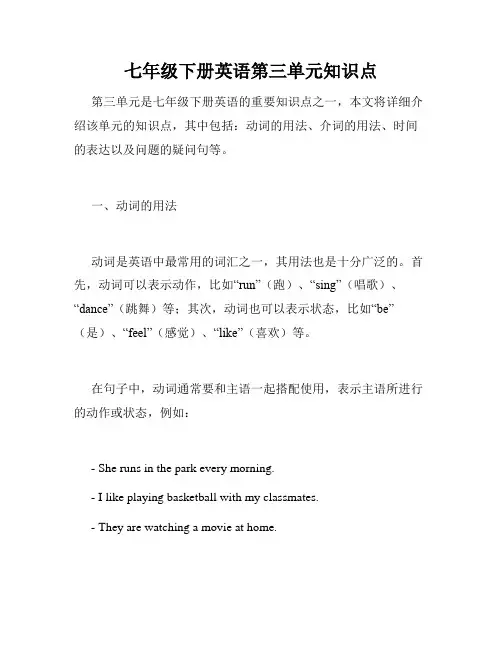
七年级下册英语第三单元知识点第三单元是七年级下册英语的重要知识点之一,本文将详细介绍该单元的知识点,其中包括:动词的用法、介词的用法、时间的表达以及问题的疑问句等。
一、动词的用法动词是英语中最常用的词汇之一,其用法也是十分广泛的。
首先,动词可以表示动作,比如“run”(跑)、“sing”(唱歌)、“dance”(跳舞)等;其次,动词也可以表示状态,比如“be”(是)、“feel”(感觉)、“like”(喜欢)等。
在句子中,动词通常要和主语一起搭配使用,表示主语所进行的动作或状态,例如:- She runs in the park every morning.- I like playing basketball with my classmates.- They are watching a movie at home.此外,动词还有时态和语态的区别,需要根据上下文和语境正确使用。
二、介词的用法介词是一种连接词,在英语中也是常用的词汇之一。
介词通常是用来表示一个名词或代词与其他词之间的关系,例如:- I am sitting on the chair.- She is walking in the street.- He is talking to his friend.注意,介词要根据名词或代词的性质和所处的位置来选择,同时也需要注意一些固定搭配,如“on time”(准时)、“in the morning”(早晨)等。
三、时间的表达在日常生活中,时间的表达是我们经常使用英语的场合之一。
英语中有许多表达时间的短语和句子,例如:- What time is it?(现在几点了?)- I usually get up at 6:30 in the morning.(我通常早上六点半起床。
)- It’s Monday today.(今天是星期一。
)此外,英语中也有表示日期、月份、年份的表达方式,也需要我们进行掌握和运用。
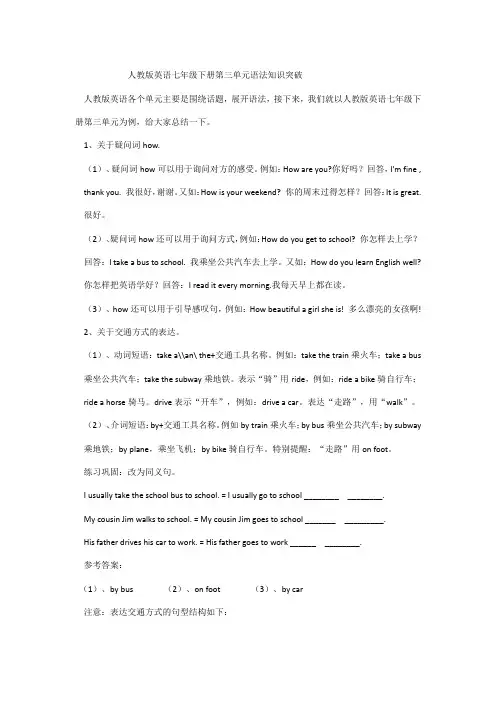
人教版英语七年级下册第三单元语法知识突破人教版英语各个单元主要是围绕话题,展开语法,接下来,我们就以人教版英语七年级下册第三单元为例,给大家总结一下。
1、关于疑问词how.(1)、疑问词how可以用于询问对方的感受。
例如:How are you?你好吗?回答,I'm fine, thank you. 我很好,谢谢。
又如:How is your weekend? 你的周末过得怎样?回答:It is great.很好。
(2)、疑问词how还可以用于询问方式,例如:How do you get to school? 你怎样去上学?回答:I take a bus to school. 我乘坐公共汽车去上学。
又如:How do you learn English well?你怎样把英语学好?回答:I read it every morning.我每天早上都在读。
(3)、how还可以用于引导感叹句,例如:How beautiful a girl she is! 多么漂亮的女孩啊!2、关于交通方式的表达。
(1)、动词短语:take a\\an\ the+交通工具名称。
例如:take the train乘火车;take a bus 乘坐公共汽车;take the subway乘地铁。
表示“骑”用ride,例如:ride a bike骑自行车;ride a horse骑马。
drive表示“开车”,例如:drive a car。
表达“走路”,用“walk”。
(2)、介词短语:by+交通工具名称。
例如by train乘火车;by bus乘坐公共汽车;by subway 乘地铁;by plane,乘坐飞机;by bike骑自行车。
特别提醒:“走路”用on foot。
练习巩固:改为同义句。
I usually take the school bus to school. = I usually go to school ________ ________.My cousin Jim walks to school. = My cousin Jim goes to school _______ _________.His father drives his car to work. = His father goes to work ______ ________.参考答案:(1)、by bus (2)、on foot (3)、by car注意:表达交通方式的句型结构如下:(1)、主语+表示交通方式的动词短语+to + 地点;例如:I take the plane to Beijing.我乘坐飞机去北京。

Unit3 How do you get to school?【重点单词】train [treɪn] n. 火车bus [bʌs] n. 公共汽车;公交车subway [ sʌbweɪ] n. 地铁take the subway 乘地铁ride [raɪd] v. 骑n. 旅程bike [baɪk] n. 自行车ride a bike 骑自行车sixty [ sɪkstɪ] n. 六十seventy [ sevntɪ] n. 七十eighty [ eɪtɪ] n. 八十ninety [ naɪntɪ] n. 九十hundred [hʌndrəd] n. 一百minute [ mɪnɪt] n. 分钟far adv.&adj远;远的kilometer n.公里new adj.新的;刚出现的every adj.每一;每个every day 每天by prep.(表示方式)乘(交通工具)by bike 骑自行车drive v.开车car n.小汽车;轿车live v.居住;生活stop n.车站;停止think of 认为cross v.横过;越过river n.河;江many adj.&pron.许多village n.村庄;村镇between prep.介于…之间between…and…在……和……之间bridge n.桥boat n.小船Ropeway n.索道year n.年;岁afraid adj.害怕;惧怕like prep.像;怎么样leave v.离开dream n.梦想;睡梦v.做梦true adj.真的;符合事实的come true 实现;成为现实【重点短语】1. get to school 到达学校2. take the train 乘火车3. take the subway 乘地铁4. ride a bike 骑自行车5. how do you get to school 怎么到达学校6. one hundred and five 1057. how far 多远8. how long 多长时间9. it takes sb some time to do sth 它花费某人多长时间做某事10. ride the bike to school 骑自行车到学校11. walk to , drive to ,fly to…步行去…;开车去…;坐飞机去….12. every day 每天13. I’m not sure 我不敢确信14. about= around 大约15. 10 kilometers 十公里16. good exercise 好的锻炼17. drive his car to work 开车去上班18. in his father’s car 坐父亲的车19. need about 10 minutes to get to school 需要十分钟的时间到达学校20. what do you think of…=how do you like…你觉得怎么样21. cross the river 过河22. It is easy to get to school. 到达学校很容易。
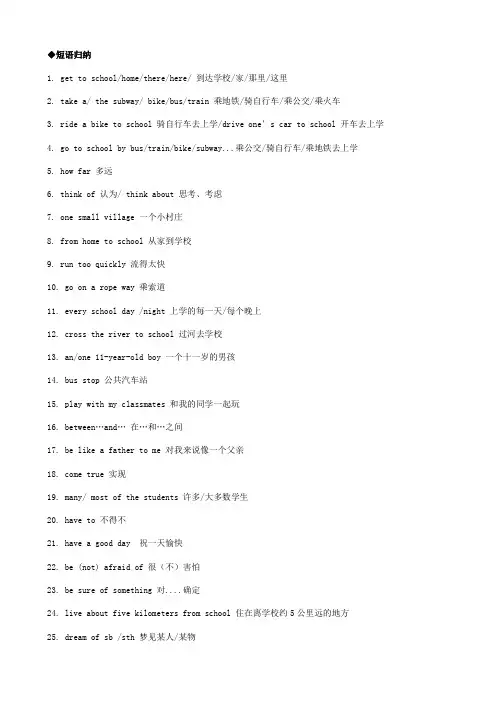
◆短语归纳1. get to school/home/there/here/ 到达学校/家/那里/这里2. take a/ the subway/ bike/bus/train 乘地铁/骑自行车/乘公交/乘火车3. ride a bike to school 骑自行车去上学/drive one’s car to school 开车去上学4. go to school by bus/train/bike/subway...乘公交/骑自行车/乘地铁去上学5. how far 多远6. think of 认为/ think about 思考、考虑7. one small village 一个小村庄8. from home to school 从家到学校9. run too quickly 流得太快10. go on a rope way 乘索道11. every school day /night 上学的每一天/每个晚上12. cross the river to school 过河去学校13. an/one 11-year-old boy 一个十一岁的男孩14. bus stop 公共汽车站15. play with my classmates 和我的同学一起玩16. between…and… 在…和…之间17. be like a father to me 对我来说像一个父亲18. come true 实现19. many/ most of the students 许多/大多数学生20. have to 不得不21. have a good day 祝一天愉快22. be (not) afraid of 很(不)害怕23. be sure of something 对....确定24. live about five kilometers from school 住在离学校约5公里远的地方25. dream of sb /sth 梦见某人/某物26. pen pal 笔友◆用法集萃1. take…to…= go to…by… 乘…去…2. How do/does sb get to…? 某人是怎样到…的?3. How far is it from…to…? 从…到…有多远?4. It takes sb. some time to do sth. 做某事花费某人多长时间。
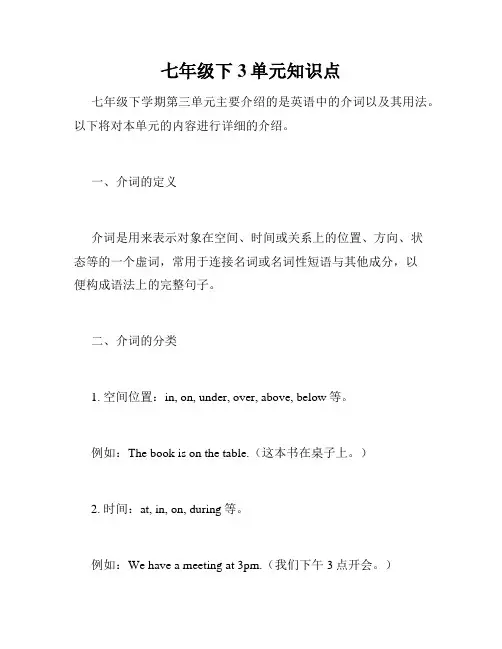
七年级下3单元知识点七年级下学期第三单元主要介绍的是英语中的介词以及其用法。
以下将对本单元的内容进行详细的介绍。
一、介词的定义介词是用来表示对象在空间、时间或关系上的位置、方向、状态等的一个虚词,常用于连接名词或名词性短语与其他成分,以便构成语法上的完整句子。
二、介词的分类1. 空间位置:in, on, under, over, above, below等。
例如:The book is on the table.(这本书在桌子上。
)2. 时间:at, in, on, during等。
例如:We have a meeting at 3pm.(我们下午3点开会。
)3. 关系:of, from, to, with等。
例如:I am good at English.(我擅长英语。
)4. 方向:to, from, towards, away from等。
例如:She walks towards the park.(她往公园走。
)三、介词的用法1. in, on, at的用法a. in用于时间段中,表示较长的时间,如年份、季节、月份等。
例如:I was born in 2005.(我出生于2005年。
)b. on用于表示具体某天。
例如:We have a party on Friday.(我们周五有聚会。
)c. at用于时间点,如某个时刻、准确时间等。
例如:She will meet me at 9am.(她将在早上9点与我见面。
)2. in的其他用法a. 表示地点、位置。
例如:The cat is in the box.(猫在盒子里。
)b. 表示状态、情况。
例如:He is in a bad mood.(他情绪低落。
)c. 表示活动、行动等。
例如:We are always interested in sports.(我们总是对运动感兴趣。
)3. on的其他用法a. 表示物体的表面。
例如:There is a book on the desk.(桌子上有一本书。
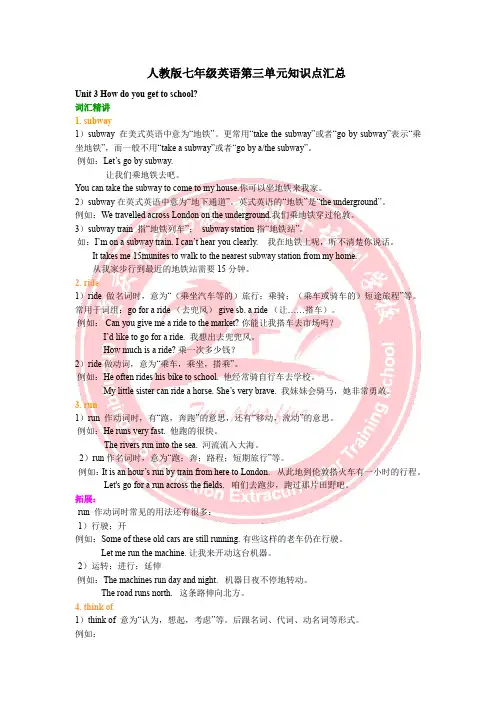
人教版七年级英语第三单元知识点汇总Unit3 How do you get to school?词汇精讲1. subway1)subway 在美式英语中意为“地铁”。
更常用“take the subway”或者“go by subway”表示“乘坐地铁”,而一般不用“take a subway”或者“go by a/the subway”。
例如:Let’s go by subway.让我们乘地铁去吧。
You can take the subway to come to my house.你可以坐地铁来我家。
2)subway在英式英语中意为“地下通道”。
英式英语的“地铁”是“the underground”。
例如:We travelled across London on the underground.我们乘地铁穿过伦敦。
3)subway train 指“地铁列车”;subway station指“地铁站”。
如:I’m on a subway train.I can’t hear you clearly. 我在地铁上呢,听不清楚你说话。
It takes me 15munites to walk to the nearest subway station from my home.从我家步行到最近的地铁站需要15分钟。
2. ride1)ride 做名词时,意为“(乘坐汽车等的)旅行;乘骑;(乘车或骑车的)短途旅程”等。
常用于词组:go for a ride(去兜风)give sb. a ride(让……搭车)。
例如:Can you give me a ride to the market?你能让我搭车去市场吗?I’d like to go for a ride. 我想出去兜兜风。
How much is a ride?乘一次多少钱?2)ride做动词,意为“乘车,乘坐,搭乘”。
例如:He often rides his bike to school. 他经常骑自行车去学校。
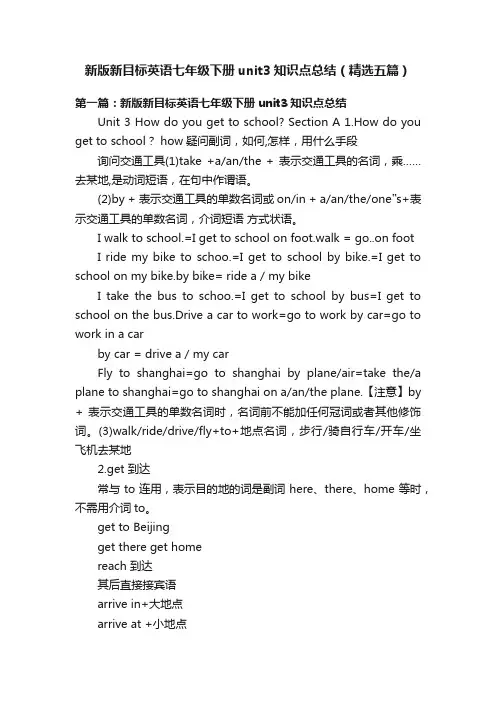
新版新目标英语七年级下册unit3知识点总结(精选五篇)第一篇:新版新目标英语七年级下册unit3知识点总结Unit 3 How do you get to school? Section A 1.How do you get to school? how疑问副词,如何,怎样,用什么手段询问交通工具(1)take +a/an/the + 表示交通工具的名词,乘……去某地,是动词短语,在句中作谓语。
(2)by + 表示交通工具的单数名词或on/in + a/an/the/one‟s+表示交通工具的单数名词,介词短语方式状语。
I walk to school.=I get to school on foot.walk = go..on footI ride my bike to schoo.=I get to school by bike.=I get to school on my bike.by bike= ride a / my bikeI take the bus to schoo.=I get to school by bus=I get to school on the bus.Drive a car to work=go to work by car=go to work in a carby car = drive a / my carFly to shanghai=go to shanghai by plane/air=take the/a plane to shanghai=go to shanghai on a/an/the plane.【注意】by + 表示交通工具的单数名词时,名词前不能加任何冠词或者其他修饰词。
(3)walk/ride/drive/fly+to+地点名词,步行/骑自行车/开车/坐飞机去某地2.get 到达常与to连用,表示目的地的词是副词here、there、home等时,不需用介词to。
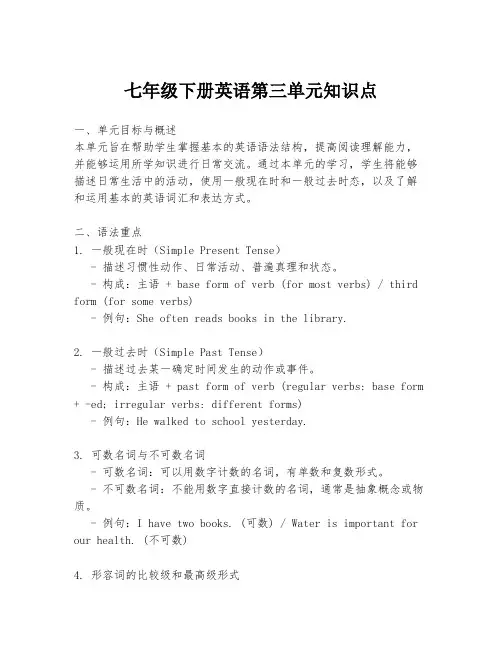
七年级下册英语第三单元知识点一、单元目标与概述本单元旨在帮助学生掌握基本的英语语法结构,提高阅读理解能力,并能够运用所学知识进行日常交流。
通过本单元的学习,学生将能够描述日常生活中的活动,使用一般现在时和一般过去时态,以及了解和运用基本的英语词汇和表达方式。
二、语法重点1. 一般现在时(Simple Present Tense)- 描述习惯性动作、日常活动、普遍真理和状态。
- 构成:主语 + base form of verb (for most verbs) / third form (for some verbs)- 例句:She often reads books in the library.2. 一般过去时(Simple Past Tense)- 描述过去某一确定时间发生的动作或事件。
- 构成:主语 + past form of verb (regular verbs: base form + -ed; irregular verbs: different forms)- 例句:He walked to school yesterday.3. 可数名词与不可数名词- 可数名词:可以用数字计数的名词,有单数和复数形式。
- 不可数名词:不能用数字直接计数的名词,通常是抽象概念或物质。
- 例句:I have two books. (可数) / Water is important for our health. (不可数)4. 形容词的比较级和最高级形式- 比较级:用于比较两者之间的差异。
- 最高级:用于比较三者或三者以上的差异。
- 例句:She is taller than her brother. / Tom runs the fastest in his class.三、词汇与短语1. 常见动词- eat, drink, play, study, work, read, write, listen,speak2. 描述日常活动的短语- do homework, watch TV, clean the room, take a shower, go shopping3. 描述过去事件的短语- went to the park, visited my grandparents, played soccer4. 形容词比较级和最高级形式- bigger/bigger/(biggest), happier/happier/(happiest),more interesting/more interesting/(most interesting)四、阅读理解通过阅读短文或对话,学生应能够理解文章的主旨大意,提取关键信息,并能够回答关于文章内容的问题。
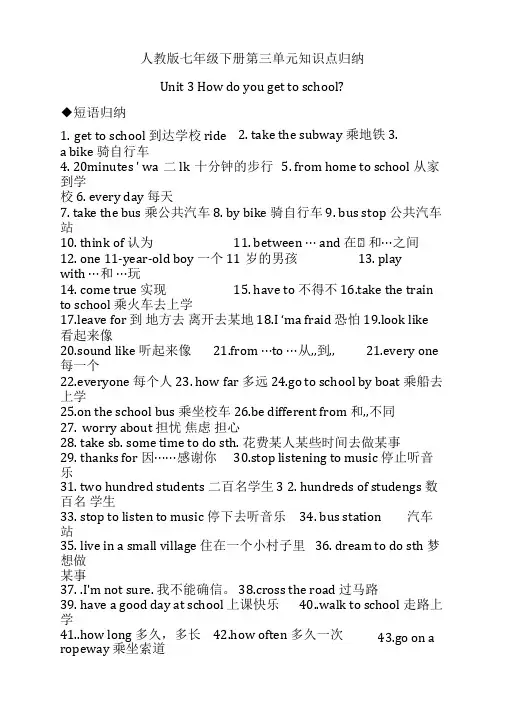
人教版七年级下册第三单元知识点归纳Unit 3 How do you get to school?◆短语归纳1. get to school 到达学校 ride a bike 骑自行车 4. 20minutes ' wa 二lk 十分钟的步行 5. from home to school 从家到学校 6. every day 每天7. take the bus 乘公共汽车 8. by bike 骑自行车 9. bus stop 公共汽车站10. think of 认为 11. between ⋯ and 在⋯ 和⋯之间 12. one 11-year-old boy 一个 11岁的男孩 13. play with ⋯和 ⋯玩 14. come true 实现 15. have to 不得不 16.take the train to school 乘火车去上学 17.leave for 到 地方去 离开去某地 18.I ‘ma fraid 恐怕 19.look like看起来像20.sound like 听起来像 21.from ⋯to ⋯从,,到,, 21.every one 每一个22.everyone 每个人 23. how far 多远 24.go to school by boat 乘船去上学25.on the school bus 乘坐校车 26.be different from 和,,不同 27. worry about 担忧 焦虑 担心 28. take sb. some time to do sth. 花费某人某些时间去做某事 29. thanks for 因⋯⋯感谢你 30.stop listening to music 停止听音乐31. two hundred students 二百名学生 3 2. hundreds of studengs 数百名 学生33. stop to listen to music 停下去听音乐 34. bus station 汽车 站35. live in a small village 住在一个小村子里 36. dream to do sth 梦想做某事37. .I'm not sure. 我不能确信。
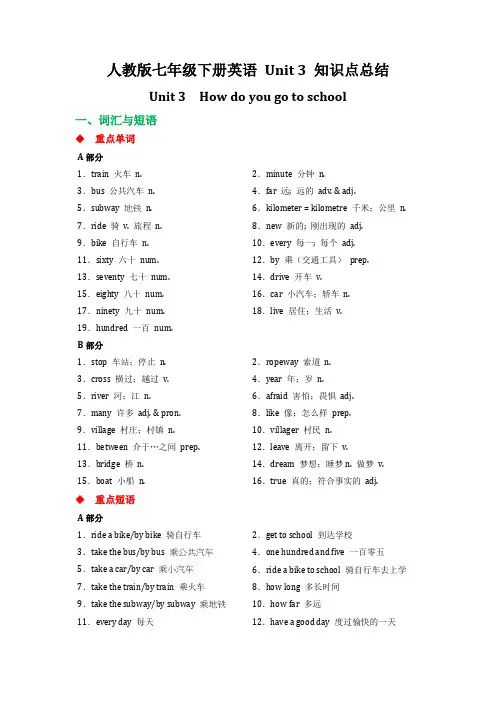
人教版七年级下册英语Unit 3 知识点总结Unit 3 How do you go to school一、词汇与短语◆重点单词A部分1.train 火车n.2.minute 分钟n.3.bus 公共汽车n.4.far 远; 远的adv. & adj. 5.subway 地铁n.6.kilometer = kilometre 千米;公里n. 7.ride 骑v. 旅程n.8.new 新的; 刚出现的adj.9.bike 自行车n.10.every 每一; 每个adj.11.sixty 六十num.12.by 乘(交通工具)prep. 13.seventy 七十num.14.drive 开车v.15.eighty 八十num.16.car 小汽车;轿车n.17.ninety 九十num.18.live 居住;生活v. 19.hundred 一百num.B部分1.stop 车站;停止n.2.ropeway 索道n.3.cross 横过;越过v.4.year 年;岁n.5.river 河;江n.6.afraid 害怕;畏惧adj.7.many 许多adj. & pron.8.like 像;怎么样prep.9.village 村庄;村镇n.10.villager 村民n.11.between 介于…之间prep.12.leave 离开;留下v.13.bridge 桥n.14.dream 梦想;睡梦n. 做梦v. 15.boat 小船n.16.true 真的;符合事实的adj.◆重点短语A部分1.ride a bike/by bike 骑自行车2.get to school 到达学校3.take the bus/by bus 乘公共汽车4.one hundred and five 一百零五5.take a car/by car 乘小汽车6.ride a bike to school 骑自行车去上学7.take the train/by train 乘火车8.how long 多长时间9.take the subway/by subway 乘地铁10.how far 多远11.every day 每天12.have a good day 度过愉快的一天B部分1.think of 认为;想起2.subway station 地铁站3.bus station 公共汽车站4.train station 火车站5.bus stop公共汽车站台6.between…and…在…和…之间7.come true 实现;成为现实8.go on a ropeway 滑索道9.an/one 11-year-old boy 一个十一岁的男孩◆重点句子A部分1.How far is it from your home to school? 从你家到学校有多远?2.— How long does it take you to get to school? 你到学校花费多长时间?— About 15 minutes by bike. 骑车需要大约15分钟。
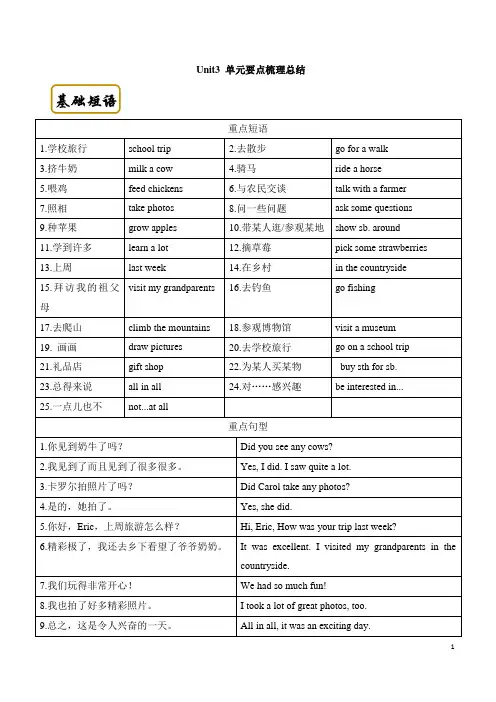
Unit3 单元要点梳理总结重点短语1.学校旅行school trip2.去散步go for a walk3.挤牛奶milk a cow4.骑马ride a horse5.喂鸡feed chickens6.与农民交谈talk with a farmer7.照相take photos 8.问一些问题ask some questions9.种苹果grow apples 10.带某人逛/参观某地show sb. around11.学到许多learn a lot 12.摘草莓pick some strawberries13.上周last week 14.在乡村in the countrysidevisit my grandparents 16.去钓鱼go fishing15.拜访我的祖父母17.去爬山climb the mountains 18.参观博物馆visit a museum19. 画画draw pictures 20.去学校旅行go on a school trip21.礼品店gift shop 22.为某人买某物buy sth for sb.23.总得来说all in all 24.对……感兴趣be interested in...25.一点儿也不not...at all重点句型1.你见到奶牛了吗?Did you see any cows?2.我见到了而且见到了很多很多。
Yes, I did. I saw quite a lot.3.卡罗尔拍照片了吗?Did Carol take any photos?4.是的,她拍了。
Yes, she did.5.你好,Eric,上周旅游怎么样?Hi, Eric, How was your trip last week?6.精彩极了,我还去乡下看望了爷爷奶奶。
It was excellent. I visited my grandparents in thecountryside.7.我们玩得非常开心!We had so much fun!8.我也拍了好多精彩照片。
人教版英语七年级下册第三单元知识梳理English:In the third unit of the seventh grade English textbook of the People's Education Press, students will learn about past events and experiences. They will learn to use the simple past tense to talk about past actions and events, and learn to use time markers like "yesterday", "last week", "two days ago", etc. They will also learn about the irregular verbs in the past tense, and practice using them in sentences. In addition, students will learn to ask and answer questions about past experiences using the simple past tense. They will also learn about the usage of "used to" to talk about past habits and states. Furthermore, students will learn about the characteristics of personal narratives and how to write one, including using chronological order, descriptive details, and personal reflection. Through various exercises and activities, students will have the opportunity to apply what they have learned and practice using the simple past tense and related vocabulary.中文翻译:在人教版七年级英语教材的第三单元中,学生将学习过去的事件和经历。
人教版英语七年级下册第三单元知识点知识点讲解一、重点词组及短语:1. ________ ________ ________学校规章制度2. _______/ _______ _______ ________遵守规章制度;_______ ______ _______违反规章制度3. _______ _______ _______ ________ = _______ _______ _______ ________ 上课迟到4. _______ ________饭厅,餐厅5. _______ ________ 在课堂上6. _______ ________ 准时(_______ ________及时)7. _______ _______ _______ ________ 在教室里吃东西8.. _______ _______ _______ 戴帽子 9. _______ _______…听…10. ________ ________校服 11. ________ ________穿制服12. ________ ________ 我明白了 13. ________ ________do 不得不做14. _______/ _______ _______保持安静16. _______(_______)_______ 制订规则 18. _______ ______ _______在上学期间19. _______ ______ _______在校期间的晚上20. _______ _______ _______ = _______ _______ _______ ________练习弹钢琴[practice doing …练习做…]21. _______ ________外出 22. _______ ________看望朋友23. _______ _______ ________ = _______ _______ _______打扫房间24. _______ _______ ________ 洗餐具25. _______ _______ / _______ _______太多的(可数/不可数 )26. _______ _______ ________ = _______ _______ _______铺床27. _______ _______ ________ 去睡觉_______ _______ _______在床上28. _______ _______ (sb/sth/doing sth)考虑(某人/某物/做某事)29. _______ _______ _______ sb ________sth 对某人要求严格30. _______ _______ _______ ________学(做某事)31. _______ _______ _______ = _______ _______不要说话。
七年级下册第三单元知识总结1.乘坐交通工具的方式:①take +a/an/the+交通工具(放句中)特殊的是自行车不能用take②by+交通工具(放句尾)③in/on+a/an/the+交通工具(放句尾)例如:我每天乘坐公共汽车去上班。
用以上三种表达方式是:I go to work by bus.I take a/the bus to work.I go to work on a bus.She goes to school by car.She takes a/the car toschool.She goes to school in a car.2.特殊的是ride a bike 而不能说take abikedrive a car 也可以是take acarHe rides a bike to school.He goes to school by bike.He rides to school.可以省略bikeHe drives to school.可以省略carride除了动词骑之外,还有名词一段路程的意思go for a ride去兜风give me a ride 让我搭个便车get sb. a ride打顺车half an hour's ride半小时的路程The bus ride takes me about20 minutes. 公共汽车之旅花费我20分钟。
3.步行到学校Walk to school=go to schoolon footon foot放到句末4.对交通方式提问用how如:I go to school by bike.对by bike提问用 How doyou go to school?5.三个到达:get to/arrive in/at/reach只有reach后面不加介词arrive in+大地点arrive at+小地点6.train ①火车②训练7.take a walk=have a walk 散步go out for a walk出去散步8.What about =how aboutdoing sth?做某事怎么样呢?因为about是介词,后面用动词ing9.hundred百 thousand 千million 百万当前面加数字时它们都不加s当前面没有数字,后面加of时他们加s如:hundreds of 成百上千的thousands of成千上万的10.本单元有一个最重要的句型:It takes sb.+时间+to do sth.sb.用宾格 take译为花费例如:It takes me ten minutes to goto school on foot.翻译的时候从后往前面翻译:步行去学校花费我十分钟对以上句子中的ten minutes提问是本单元的第二个重点句型:How long does it take you togo to school on foot?译为:步行到学校需要花费你多久?对这个句型的回答一般用How long,但是因为在原句型中时间前面没有for,所以回答时不用for比较以下两个句子:How long does it take you togo to school on foot?Ten minutes.How far is it from your hometo school?Ten minutes' walk.译为:10分钟的路程。
Unit 3 How do you get to school?1.短语归纳2.典句必背3.用法集萃(1)怎样表达出行方式:How do you get to school?❖描述出行方式时,通常会有如下几种形式注意:当交通工具的名词(如:bike, bus, train, car等)和by搭配时,它们前面不必加冠词;但当它们和on或in搭配时,它们之间要加冠词。
(2)基数词的表达法:基数词,表示数目或者数量的多少①one 到twelve,拼写和读音没有什么相似之处,无规律可言,应逐一进行记忆。
②thirteen到nineteen,表示“十几”,在个位数后加后缀-teen,读作/ti:n/。
注意thirteen, fifteen和eighteen的拼写。
③twenty到ninety,表示“几十”,以-ty结尾,但需注意下面几个词的拼写:twenty, thirty, forty, fifty, eighty。
④21~29直到91~99,表示“几十几”,用整十位加个位数表示,中间用连字符“-”把十位数与个位数连接起来。
例:21→twenty-one;35→thirty-five⑤one hundred意为“一百”,表示一百还可以用 a hundred。
要表示200~900,用“具体数字+hundred”。
⑥例:200 →two hundred;900→ nine hundred注意:❖hundred前面若有具体的数词,则要用hundred的单数形式,而且其后不能跟of,此时表达确切的数字概念。
例:There are two hundred people in the square. 广场上有两百人❖hundreds of表示“数以百计的”,此时表达模糊的数字概念。
如:There are hundreds of people in the square. 广场上有好几百人(3)How far is it from your home to school?❖from ... to ... 意为“从...到...”,表示“由一点到另一点”,可用于时间、地点、数目等。
人教版七年级英语下册Unit 3 How do you get to school一、单词回顾1、train[treɪn]火车2. bus 公交车3、subway['sʌbweɪ]地铁4、ride[raɪd]v.骑n.旅rode. [rəʊd]ridden.['rɪdn.]5、bike[baɪk]自行车6、sixty['sɪkstɪ]六十7、seventy['sev (ə)ntɪ]七十8、eighty['eɪtɪ]八十9、ninety['naɪntɪ]九十10、hundred['hʌndrəd]一百11、far[fɑː]很12、minute['mɪnɪt]分钟13、kilometer['kɪlə,mitɚ]公里14、new[n juː]新的15、every ['evrɪ]每一个16、by[baɪ]通过,被17、drive[draɪv]开车18、live [lɪv]活的,生动的19、stop[stɒp]停止20、cross[krɔs]交叉21、river ['rɪvə]河,江22、many ['menɪ]许多23、village[' vɪlɪdʒ]村庄,村民24、between[bɪ'twiːn]介于…之间25、bridge[brɪdʒ]桥26、boat [bəʊt]小船27、ropeway['rop,we]n. 索道空中缆索28、year[jɪə]n. 年;年度;岁29、afraid[ə'freɪd]害怕;惧怕30、like [laɪk]像;怎么样(介词)31、leave [liː v]离开;left (lea ve的过去式)32、dream[driːm]梦想;睡梦33、true[truː]真的;符合实际的二. 词汇辨析:1. take/spend/pay/costspend,cost,take和pay都可以表示“花费”,但用法却不尽相同。
人教版七年级英语下册第三单元知识点汇总01、重点短语1. get to 到达2. walk to school=go to school on foot 步行去学校3. on foot 步行4. hundreds of 数以百计的5. every day 每天6. take the bus/train/subway 乘公交车/火车/地铁7. ride a bike 骑自行车=by bike8. how far 多远9. how long 多久/ 多长10. how soon 多久之后11. from home to school 从家到学校12. think of 认为,想起13. cross the river to school 穿过河去学校14. an 11-year-old boy 一个11岁的男孩15. between...and... 在......和......之间16. be afraid of 害怕17. go on a ropeway 乘坐索道18. be like 像19. come true 实现20. thanks for 因......而感谢21. have a good day 过得愉快02、重点句子Grammar Focus 句子How do you get to school?你怎样到学校?I ride my bike.我骑自行车。
How does she get to school?她怎样到学校?She usually takes the bus.她通常乘公交车。
How long does it take to get to school? 到学校要用多长时间?It takes about 15 minutes.大约要用15分钟。
How far is it from your home to school? 从你家到学校有多远?It’s only about two kilometers.只有大约两千米。
123知识点讲解4一、重点词组及短语:51. ________ ________ ________学校规章制度62. _______/ _______ _______ ________遵守规章制度;_______ ______ 7_______违反规章制度83. _______ _______ _______ ________ = _______ _______ _______ 9________ 上课迟到104. _______ ________饭厅,餐厅5. _______ ________ 在课堂上116. _______ ________ 准时(_______ ________及时)7. _______ _______ _______ ________ 在教室里吃东西12138.. _______ _______ _______ 戴帽子9. _______ _______…听…1410. ________ ________校服11. ________ ________穿制服12. ________ ________ 我明白了13. ________ ________do 不得不做151614. _______/ _______ _______保持安静1716. _______(_______)_______ 制订规则18. _______ ______ _______ 18在上学期间1919. _______ ______ _______在校期间的晚上2020. _______ _______ _______ = _______ _______ _______ ________练习21弹钢琴22[practice doing …练习做…]2321. _______ ________外出22. _______ ________看望朋友2423. _______ _______ ________ = _______ _______ _______打扫房间2524. _______ _______ ________ 洗餐具2625. _______ _______ / _______ _______太多的(可数/不可数)2726. _______ _______ ________ = _______ _______ _______铺床2827. _______ _______ ________ 去睡觉_______ _______ _______在床上2928. _______ _______ (sb/sth/doing sth)考虑(某人/某物/做某事)3029. _______ _______ _______ sb ________sth 对某人要求严格30. _______ _______ _______ ________学(做某事)313231. _______ _______ _______ = _______ _______不要说话。
33二、知识点解析1..Ms./Mrs./Miss.3435Ms.:“女士”,用于婚姻状况不明或不想区分婚否的女子的姓前。
36Mrs.:“夫人”,用于已婚女子姓前。
37Miss.:“小姐”用于未婚女子姓前,还常用于年轻的女教师的姓前,可译为38“老师”。
392. in time和on time区别_______ _______ “及时”,指没有迟到,时间还充裕;4041_______ _______ “准时,按时”,指按规定的时刻不早不晚。
42He always go to school_______ time.他总是按时上学。
Fireman reached the house on fire _______ time.消防员及时赶到那幢失4344火的房子。
453.hear、listen和sound46hear"听说"侧重于"听"的内容;listen"听"侧重于"听"这一动作;47sound"听起来"它是系动词后面接形容词等48I'm sorry to ____ that you are ill. 听说你生病了我很难过。
It 49____ like fun. 听起来挺有趣。
50That _______ great. 那听着真很好。
_______ _______ me carefully. 认51真听我说。
52The children like to_______ _______ music. 孩子们喜欢听音乐。
534.辨析take,bring54take“带走,拿走”指把东西从说话地带到别的地方;bring“带来”指把东55西从别处带到说话地。
56Can you help me to____ the books to the classroom?你能帮我把这些书57带到教室里去吗?_______ your homework here tomorrow,please.请你明天把作业带到这儿来。
58595.be strict with sb “对某人严厉”be strict in (doing) sth “对某事要求严格”6061Mr. White is very strict _______ us. 怀特先生对我们要求很严格。
62We should be strict _______ ourselves. 我们应该对自己要求严格。
63Our boss is strict _______ our work. 我们的老板对我们的工作要求严64格。
656.remember“记得,记住”,forget“忘记,忘了”,66remember____ sth记得已做某事(已做);remember ___ __ sth 记得67要做某事(还没做)68I remember seeing him once.我记得见过他一次。
69Remember to post the letter for me.记得给我寄这封信。
707.help “帮助”,71help sb ___ ______ sth帮助某人做某事;help还可作名词,表示“帮助”,72是不可数。
73help sb _______ sth(n.)帮助某人做某事;help oneself to+n.请随便用…74I often help him with his lessons.我常帮他学功课。
75Please help yourselves to some fruit.请随便吃些水果。
768.too many, too much与much too77【典型例题】78I have ________skirts and this one is ________large for me, so you can79take it if you like.A. too many; too muchB. too much; much tooC. too many; much too80819.either,too与alsoEnglish.82【典型例题】I don’t like her, 83________. A.also B.too C.either D.to8410. _______ _______= _______ _______ _______ _______玩得开心,过得85愉快8611.No talking ! "禁止交谈。
"no后面加上名词或动名词doing也表示不要做某事。
8788与don't +do的用法相似。
89Eg: _______wet umbrellas! /_______put wet umbrellas here! 禁止放湿雨伞9091_______food! _______ eat food here! 禁止吃食物_______smoking! _______smoke here! 禁止吸烟9293三、重点语法941. 情态动词have to 的用法:意思是"必须、不得不"它侧重于客观上的必要和外界的权威。
9596●结构:主语+have to+动词原形+其他97●一般现在时:主语是第三人称单数时用has to,其它时候用have to98(过去时:无论人称和单复数都用had to.)99Eg:We_______ _______ wear sneakers for gym class. 在体育课上我们100必须穿运动鞋。
Tom _______ _______ practice the guitar every day. 汤姆每天必须练101102习弹吉它。
103●否定形式:主语+don't have to+动词原形+其他104●一般现在时:主语是第三人称单数时用doesn't have to,其它时候用don't 105have to.106(过去时: 无论人称和单复数都用didn't have to)Eg:Nick _______ _______ _______ wear a uniform. 尼克不必穿制服。
107108We_______ _______ _______ do our homework at once. 我们不必马上完109成作业。
●疑问句:Do 、Does或Did+主语+have to +动词原形+其他110111Eg:---Do you have to stay at home on weekends? 周末你必须呆在家里112吗113---_____,_____ _____是的我必须。
/ ______,_____ ______不我不114必。
115【典型例题】116Lucy has to wear sports shoes for gym class.(该为否定句)117Lucy ________ ________ _______ wear sports shoes for gym class.1182.情态动词must的用法:119must表示说话人的主观看法,及主观上的必要性,还用于命令或愿望。
只用于现在时,无人称和单数的变化。
在表示过去、将来和完成时,用have to的120121相应形式来代替must.122●在表示有做某一个动作的必要和义务,它的意思是“必须,应该”。
123Eg:You must finish your homework fist.你必须先完成作业。
124●表示有很大把握的判断或者推测,意思是“一定,准是”。